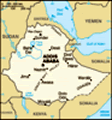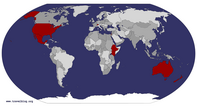Advertisement
Published: November 9th 2013
A “hike” in the Entoto Mountains I wake up well before my alarm and I’m rarin’ to go. Today, we have a choice between a stroll around the neighborhood or a hike in the Entoto Mtns. I strap on my binocular harness, combine my small water bottles into the larger one, and I’m ready to hike. No doubt in my mind which will be my choice. I’m hoping to do some good birding as I feel this is the one chance I can be legitimately distracted from the group trip. (Remember, Marit, you are not here for the wildlife viewing!)
In our private bus, we wind through Addis sprawl. Corrugated tin shacks, plastered wall shops, looming empty-looking concrete buildings and people everywhere. As yesterday, I do not notice any change in neighborhoods or flavor of the area. It’s unzoned, unregulated (seemingly) sprawl, repeated over and over.
We start heading up, the engines chugging doggedly along. We start to pass more donkeys and women (only women) carrying enormous bundles of eucalyptus branches. The branches are longer than the women are tall and the women bend double to carry their heavy, precarious load on middle and small of the back.
Eucalyptus groves becomes forests and I’m amazed at their slenderness and abundance. During the ride, I learn to my slight disappointment but with no surprise that our “hike” will only be an hour (out of 3) and will be downhill. So much for my energetic preparation this morning!
Finally we’re let out of the vehicles in the midst of a small collection of shops and a brightly painted church that reminds me of a carousel. We wind our way past the shops and then through housing, down roads that clearly never see a vehicle considering anything but a motorbike would immediately break an axel or get stuck in an oversized pothole. Eventually the houses drop behind and we enter a meadow area surrounded by gum (eucalyptus) forests. The mad dash of human life slips away and we’re in a bucolic setting with yellow-ripe grasses, trilling birds and a true blue sky above. From afar, the vision of women with their eucalyptus burdens form a peaceful part of the landscape, but I shudder to think what those bundles are doing to their backs.
In the meadow, we come upon a tidy brick wall encircling a stone and granite memorial.
It’s dedicated to the memory of those lost in 9/11….How random and frivolous this thing seems placed here with no connection to the land or the people. And empty and expensive gesture in a too-often disconnected and troubled land.
Walking back, we loop through the gum forest and I am amazed again to see how skinny these trees are. Every single one is coppiced multiple times, jagged chops at the base likely made by machetes. I ask our guide, an accountant who used to work for JDC, about this non-native, odd forest. And sure enough, he tells me that Emperor Menelik imported the gums in the late 1800’s to solve the firewood problem. Well, they’re certainly being used but I wonder if it just prolonged the issues that come with population explosions and increased urbanization without adequate infrastructure. And again, I wonder what the land looked like before these non-native forests. Too late now…The entirety of the Entoto Mountains is either covered in gum trees or people.
I notice as we wind our way back that while many people do ask for money or water bottles (kids and adults) we are not as surrounded as I often was

 Gum forest
Gum forest
See the jagged cuts and the multiple resprouts in each tree?in Kenya. I think that might be because foreign tourism (or domestic tourism?) is not nearly as prevalent here in Ethiopia. And even when they ask, no one is pushy or very persistent (relatively speaking). I find it easy enough to skirt the perimeter of my group and watch the interactions without involving myself. I find I am deeply uncomfortable walking through the town section as my companions snap photos of the individuals they come across. I rarely photograph people when I travel, except from afar or in large groups which feels more removed and less invasive to me. And here I’m with a group where folks even peer with their lens into people’s yards, through open gates and the many gaps in the never-straight wooden fences. The photographed don’t seem to mind, either laughing or repeatedly pursing up their hands to signal money, asking for it in Amharic or heavily accented English. I find some relief in not seeing anyone get upset but still I shy away, hoping we do not give offense. Hope we do not distance ourselves from these people by inadvertently treating them as a tourist attraction. I know that is not in the minds of

 Misha and the bundle
Misha and the bundle
Our military man trying to shoulder the burden. The woman behind him is the owner of this bundleanyone in this group but still…I resolve that when I am home, I will take my camera and go photograph my fellow Americans. Just to see what it’s like to obviously photograph strangers in my own backyard.
Back on the bus, we stop at an overlook and while we’re there, a woman with a wood bundle passes by and stops. She sits down with a thump on a rock outcrop, letting her load down. Our guide, at the behest of some folks in our group, convinces her to let some folks try to lift her bundle, for a small donation in birr. Three people try (2 guys, 1 girl) and all exclaim at the weight and the difficulty of balancing. Misha, our military-trained physician’s assistant, estimates it at 80lbs, way more than half this petite woman’s weight. I wonder at the woman’s age. So hard to tell because life can be so hard on a body and a face in places like this. This is likely her “job” and I wonder how long she’s been at it and how much longer she will last before her body breaks.
More than a college education Back at the hotel,

 Injera!
Injera!
Made of teff, a small grain native to Ethiopiawe reconvene to talk with Unity College accounting students whose college career is funding through JDC scholarships. All the recipients are female. The selected representatives have dressed with care (far more than we did…) and they all speak quietly and often with averted eyes, a trait I noticed in Kenyan women as well. Our conversations are rather forced and the guided discussion does little to ease that. However, the girls I am talking with in my group soldier on with the awkward situation and contribute, so quietly we have to duck our heads in close to hear. The conversations highlight the difficulties of getting a rural education considering the lack of adequate schooling, even at the primary level, in many areas outside Addis and the persistent issues that affect women in Ethiopia, including higher education gaps and other scary social situations like forced marriages (through kidnapping). However, the Unity College director emphasizes and the girls agree that things are changing, especially in the last decade when non-Addis colleges have quadrupled in number. These shy but unshakable girls know that their achievements have a meaning far beyond themselves or even their family.
Oh, I want to learn how to dance 
 Yod Abyssinia Ethiopian Restaurant
Yod Abyssinia Ethiopian Restaurant
Some of the crew in the crowded, comfy restaurant with the awesome dancers (photo courtesy of Shuli)like this…
To round off this topsy turvy Saturday, we go to the Yod Abyssinia Ethiopian Restaurant. As soon as we walk in, I’m enamored. The place holds a comfortable swarm of people, a mix of foreigners and natives (though likely wealthier Ethiopians…). Behind us is a full set of Asian and Ethiopian men and I’m guessing it’s a social business outing. The seating is packed in tightly, little hubs around small round tables that have barely enough room to hold drinks much less plates. Many people balance plates on their laps, eating with their right hand in the Ethiopian way, using injera as their scoop. The inside is brightly painted and murals of wildlife and costumery adorn the walls. A central stage occupies the main attention as a band plays iconic music of different Ethiopian tribes. Sometimes singers occupy the stage and other times a troupe of eight dancers shake their way through different tribal dances. I love watching the differences between different announced tribal dances but I notice that all of them are heavily focused on shoulders. That’s quite different to my eyes and I am astounded by the isolation control that they all have when shimmying,

 The mock marriage
The mock marriage
Shuli and Isaiah were excellent sports (photo courtesy of Rozi)shaking, popping, rolling their shoulders.
Two members of our group, the engaging, constantly enthusiastic Isaiah and the charming, comfortable Shuli, get pulled on stage and are involved in a lengthy comedy-type sketch where dancers dance for them, they get draped with white cloth, and a comedian teases them in Amharic, making the Ethiopians laugh constantly. Shuli and Isaiah grin and play along, and we cheer them on. Afterwards, there is rampant teasing about their “marriage” as they were definitely set up in a mock marriage ceremony though we couldn’t understand a lick of what was said. A great way to end our last night in Addis. Tomorrow we head north to more thoroughly dive into JDC’s programs and humanitarian issues in the Gondar region.
Advertisement
Tot: 0.093s; Tpl: 0.01s; cc: 11; qc: 28; dbt: 0.0473s; 1; m:domysql w:travelblog (10.17.0.13); sld: 1;
; mem: 1.1mb











